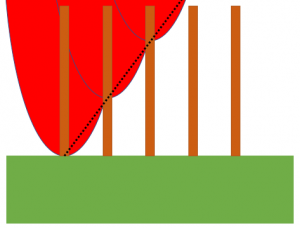Fire fronts are one of the most fascinating forms of reaction-diffusion waves. They can be devastating and dangerous but offer a great possibility to visualize RD systems. Current USDA Forest Service research is primarily done with real-scale forest fires or in large settings with, for example, bales of straw. In 2015, Harm Rotermund’s group at Dalhousie University, Halifax, Canada, published the idea, how to experimentally investigate the propagation of forest fires – in a lab environment (C. Punckt, P. S. Bodega, P. Kaira, and H. H. Rotermund, “Wildfires in the lab: Simple experiment and models for the exploration of excitable dynamics” Journal of Chemical Education 92(8), 1330-1337 (2015)). They created a match stick array as a forest. Besides some obvious (wrong) assumptions such as the ‘head-heavy’ excitation, the setup worked pretty well and the corresponding automaton model created satisfying results.
This was the lab’s starting point for various sub-projects related to fire.
Influence of the slope on propagating fire fronts
 Robin Morillo ’17 was interested in this topic and created sloped match stick arrays because Punckt et al. only looked at the horizontal case. He also updated Punkt et al.‘s MATLAB code to include the slope effect. Abigail Ambrose ’20 joined this project at the same time – in her second semester and continued until her junior year. Over the next years, the speed for upward and downward moving fire fronts were analyzed with the Tracker Video Analyzing and Modeling Tool. We are using regular digital CCD cameras and a tFLIR thermal IR-camera A325sc with a temperature resolution of 50 mK for up to 2000 °C to determine the fire front. Now, we are able to locate the hotter match head through the flames and will be able to detect the fire front more accurately.
Robin Morillo ’17 was interested in this topic and created sloped match stick arrays because Punckt et al. only looked at the horizontal case. He also updated Punkt et al.‘s MATLAB code to include the slope effect. Abigail Ambrose ’20 joined this project at the same time – in her second semester and continued until her junior year. Over the next years, the speed for upward and downward moving fire fronts were analyzed with the Tracker Video Analyzing and Modeling Tool. We are using regular digital CCD cameras and a tFLIR thermal IR-camera A325sc with a temperature resolution of 50 mK for up to 2000 °C to determine the fire front. Now, we are able to locate the hotter match head through the flames and will be able to detect the fire front more accurately.
 They developed three types of models, in which the distance between the match heads are kept constant along the horizontal (Δx-model), along the vertical (Δz-model), and along the slope (Δr-model). For each model, 3D-printed molds with angles θ between 0° and 45° were created and different speed-slope relationships for each model were found. This is in contrast to the used tan²θ-relationship developed in 1972 by Rothermel (Rothermel, R. C., A mathematical model for predicting fire spread in wildland fuels. Tech. Rep., USDA Forest Service Research Paper INT-115 (1972)) and generally used for simulating fire propagation up and down a slope.
They developed three types of models, in which the distance between the match heads are kept constant along the horizontal (Δx-model), along the vertical (Δz-model), and along the slope (Δr-model). For each model, 3D-printed molds with angles θ between 0° and 45° were created and different speed-slope relationships for each model were found. This is in contrast to the used tan²θ-relationship developed in 1972 by Rothermel (Rothermel, R. C., A mathematical model for predicting fire spread in wildland fuels. Tech. Rep., USDA Forest Service Research Paper INT-115 (1972)) and generally used for simulating fire propagation up and down a slope.
An advantage of our models, compared to the models at the Fire Research Laboratory in Missoula, MT (we visited in December 2017) is the fact that our trees/matches are always perpendicular to the ground, as vegetation usually is. In the Missoula lab, the objects are perpendicular to the sloped surface. But more work needs to be done.

Quasi-physical simulation approach using Python
 Joe Theiss ’19 wrote a Python code during his Senior I.S. to simulate the propagation of flames up and down the slope. Handeul Son ’21 expanded the existing code. They used a quasi-physical simulation approach based on heat propagation using buoyancy (warm air rises) and Newton’s law of cooling. As system parameters, they varied the slope angle, the tree height, and the tree distance. All these factors were controlled to examine their effect on fire propagation and to test why fire spreads faster uphill. One difference to the real match stick experiments is the possibility to ignite anywhere along the tree if the ignition temperature has been reached. Currently, the ignition temperature is held constant along the tree.
Joe Theiss ’19 wrote a Python code during his Senior I.S. to simulate the propagation of flames up and down the slope. Handeul Son ’21 expanded the existing code. They used a quasi-physical simulation approach based on heat propagation using buoyancy (warm air rises) and Newton’s law of cooling. As system parameters, they varied the slope angle, the tree height, and the tree distance. All these factors were controlled to examine their effect on fire propagation and to test why fire spreads faster uphill. One difference to the real match stick experiments is the possibility to ignite anywhere along the tree if the ignition temperature has been reached. Currently, the ignition temperature is held constant along the tree.
 It was found that slope, tree distance, and tree height play major roles in determining simulation outcomes and that these outcomes could be matched to real world values. They also determined a ‘burning angle’ which limits the distance a fire spreads. We plan to add other parameters, such as tree type: with and without the option of the fire burning down the trunk. This behavior influences the ignition point of the neighboring tree. Therefore, the resulting slope of the ignition points should depend significantly on these conditions.
It was found that slope, tree distance, and tree height play major roles in determining simulation outcomes and that these outcomes could be matched to real world values. They also determined a ‘burning angle’ which limits the distance a fire spreads. We plan to add other parameters, such as tree type: with and without the option of the fire burning down the trunk. This behavior influences the ignition point of the neighboring tree. Therefore, the resulting slope of the ignition points should depend significantly on these conditions.
We also plan to implement the Cellular Automaton Model Robin Morillo ’17 used with a MATLAB code into Python. Besides planar/straight fronts, we plan to investigate the influence of i) the slope on fire spirals and ii) the inhomogeneity of the matches on the shape of fire fronts. A further step would be to investigate the influence of varying slopes – as in real mountainous environments.
Match stick types
Preliminary results showed that different match stick types create fire fronts propagating with different velocities. We would like to explore the fire propagation of various match stick types. This project should be accompanied with the Cellular Automaton Model Simulation in Python to quantify the behavior of those matches.
Ring of Fire and Fire Spiral
 The 1982 documentary Never Say Never (Youtube link) about the history of the Belousov-Zhabotinsky reaction, broadcasted by Moscow State Television, shows a propagating flame, moving from candle to candle while the previous flame vanishes. This is a beautiful example of an excitable medium with an excitable state in front (i.e., saturated candle wick with oil), burning wick, and time to diffusively refueling the wick to become excitable again, the unexcitable refractory tail (i.e., oil is consumed and flame ‘dies’). Using strips of fire resistant canvas, Abigail Ambrose ’20 was able to create an excitable system by placing the canvas into an oil bath and having short fire pulses propagating across. After creating a closed 1D system, the fire pulse can propagate around, as long as the energy (oil) is available to diffuse into the canvas. Craig Klumpp ’21 explored various other materials, wicks, oils, and setups. He created, for example, a fire clock and a 1D system with different oil diffusivities to achieve alternating long and short traveling fire pulses. But more work needs to be done – and we would like to create a rotating fire spiral in a two-dimensionsal setup.
The 1982 documentary Never Say Never (Youtube link) about the history of the Belousov-Zhabotinsky reaction, broadcasted by Moscow State Television, shows a propagating flame, moving from candle to candle while the previous flame vanishes. This is a beautiful example of an excitable medium with an excitable state in front (i.e., saturated candle wick with oil), burning wick, and time to diffusively refueling the wick to become excitable again, the unexcitable refractory tail (i.e., oil is consumed and flame ‘dies’). Using strips of fire resistant canvas, Abigail Ambrose ’20 was able to create an excitable system by placing the canvas into an oil bath and having short fire pulses propagating across. After creating a closed 1D system, the fire pulse can propagate around, as long as the energy (oil) is available to diffuse into the canvas. Craig Klumpp ’21 explored various other materials, wicks, oils, and setups. He created, for example, a fire clock and a 1D system with different oil diffusivities to achieve alternating long and short traveling fire pulses. But more work needs to be done – and we would like to create a rotating fire spiral in a two-dimensionsal setup.
Senior Independent Study theses
- Craig Klumpp ’21: A Case of Heartburn: Replicating the Heart’s Electrical Signals with Fire
- Handeul Son ’21: Investigation of Fire Propagation using Discrete Tree Simulation
- Joe Theiss ’19: Slope’s Effect On Discrete Tree Fire Simulations
- Robin Morillo ’17: The Effects of Slope upon Propagation Speed and Pattern Formation in Forest Fire
NSF-REU Summer research experience
- Abigail Ambrose (2017): Forest Fire Propagation Along a Slope
Research Experiences during the academic year
- Abigail Ambrose ’20 (2017SP – 2018FA)
Oral presentations
- Abigail Ambrose: “Using Match Stick Arrays to Analyze Forest Fire Propagation along a Slope“, 2018 Annual meeting of The Ohio Academy of Science, Bowling Green, OH, USA, 2018 April 14
- Abigail Ambrose: “Using Match Stick Arrays to Analyze Forest Fire Propagation along a Slope“, Spring 2018 Meeting of the APS Ohio-Region Section, East Lansing, MI, USA, 2018 March 23-24
- Robin Morillo: “3D Printing and I.S. – A Simple Tool That Goes a Long Way“, Science Round Table at the College of Wooster, Wooster, OH, USA, 2017 April 14
Poster presentations
- J. Theiss and N. Manz: “Discrete Tree Based Fire Simulation” Spring 2019 Meeting of the APS Ohio-Region Section, Wooster, OH, USA, 2019 March 29-30
- A. Ambrose and N. Manz : “Effect of match types on the fire propagation speeds in a match stick array” Spring 2019 Meeting of the APS Ohio-Region Section, Wooster, OH, USA, 2019 March 29-30
- A. Ambrose and N. Manz: “Using Matches to Investigate Forest Fire Propagation Along a Slope” Fall 2017 Meeting of the APS Ohio-Region Section, Oxford, OH, USA, 2017 October 13-14
- R.M.P. Morillo and N. Manz: “A Hill on fire: Using matches, 3D printing, and code as a forest fire analog” 21st Annual Posters on the Hill, Washington, DC, USA, 2017 April 26 (Robin’s report in the Fall 2017 CURPA News)
- R.M.P. Morillo and N. Manz: “The Ring of Fire: The Effects of Slope upon Pattern Formation in Simulated Forest Fire Systems” APS March Meeting 2017, New Orleans, LA, USA, 2017 March 13-1
- R.M.P. Morillo and N. Manz: “Burning up: The effect of slope upon forest fire propagation” Dynamics Days 2017, Silver Spring, MD, USA, 2017 January 4-6
- R.M.P. Morillo and N. Manz: “Matchstick Forests: Studying Fire Spread On Hills Using a Scaled Model” Fall 2016 Meeting of the APS Ohio-Region Section, Bowling Green, OH, USA, 2016 October 7-8
Publications (click for more info)
- N. Manz, H. Phillips, C. Herndon, A. E. Ambrose, and F. H. Fenton, Dynamics of Table-top Fire Fronts, SIAM News Online based on the presentation at the 2019 SIAM Conference on Applications of Dynamical Systems in Snowbird, Utah (2019).
